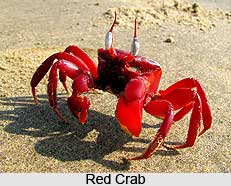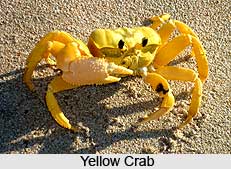 Crabs are the most dominant and highly organised decapod crustaceans, very widely distributed along the shores, sandy bottoms, sides of rocks, in brackish and fresh waters, in estuaries and mangrove mudflats, water logged rice-fields and on moist land. In a typical crab the fore-part of the body is covered by a broad shield expanded laterally, under which its water breathing organs or gills are well protected. In land crabs the gills function using the moisture in air. In some forms the upper part of the gill chamber gets modified into a sort of air-breathing lung.
Crabs are the most dominant and highly organised decapod crustaceans, very widely distributed along the shores, sandy bottoms, sides of rocks, in brackish and fresh waters, in estuaries and mangrove mudflats, water logged rice-fields and on moist land. In a typical crab the fore-part of the body is covered by a broad shield expanded laterally, under which its water breathing organs or gills are well protected. In land crabs the gills function using the moisture in air. In some forms the upper part of the gill chamber gets modified into a sort of air-breathing lung.
Of the five pairs of legs, the first pair is curved forward and is invariably stouter and larger with the extremities developed into formidable pinching claws or chelae. The other four pairs are disposed laterally or backwards and used for crawling and digging. In the swimming forms, the ends of the hind one or more pairs are flattened into oars or paddles. In the masked crabs, on the other hand, the last two pairs have hooks developed to hold a foreign object, such as, bivalve shell. Along the front portion of the shield (carapace) there are two pairs of pits or sockets through which one pair of stalked movable eyes and a pair of antennules emerges. Both these organs can be retracted into the socket.
 In all true crabs the abdomen is greatly reduced, insignificantly small and short compared to the forepart of the body. It cannot be seen from above as it is inturned or tucked beneath the shield. In male crabs the abdomen consists only of one or two segments whereas in females it is larger and has four segments. The larger the size of the female abdomen, the more it is able to accommodate the developing eggs. In Mole crabs and Hermit crabs the abdomen is large and pronounced.
In all true crabs the abdomen is greatly reduced, insignificantly small and short compared to the forepart of the body. It cannot be seen from above as it is inturned or tucked beneath the shield. In male crabs the abdomen consists only of one or two segments whereas in females it is larger and has four segments. The larger the size of the female abdomen, the more it is able to accommodate the developing eggs. In Mole crabs and Hermit crabs the abdomen is large and pronounced.
There are many families of crabs. They vary very widely in size, shape and colour, habit and habitat. In size they range from one centimetre to nearly a metre. In colour some are dull brown or black and some green, blue, red, yellow, orange and scarlet. Some have chevron patterns, streaks or dots on the shield. The shapes of the shield in crabs differ in different families. Certain crabs plant on their shields seaweeds, sponges, coelenterales etc to conceal themselves from their enemies and at the same time to capture them by surprise.
Like most crustaceans crabs are omnivorous. Their food consists of small animals, such as, snail, tadpoles, insect larvae, worms, decaying matter, tender plants, etc. In all cases the pinching claws are used to catch and crush the prey and convey the broken pieces into the mouth. One of the genus of giant crab, Birgus, common along the Pacific shores, climb up the coconut trees and with their stout pincers bore holes in coconut, extract the kernel and feed on it. Mole crabs, on the other hand, have no developed chelae. They live in sand, moving in and out with the tide. They have however plume-like antennae which catch organic matter on which they feed.
Crabs have many enemies. Most of the larger sea animals feed on them. Seashore birds-cranes, gulls, eagles, crows-swallow them. In paddy fields dogs, jackals, wild cats, ducks and waterfowl eat them up. Man is also destructive to the medium and large sized crabs; crabs being considered by many to be tastier than prawns or fish.
India has several interesting genera of crabs. There are many species of curious crabs along both shores, and around Krusadi and Lakshadweep many large-sized varieties exist in abundance.



















